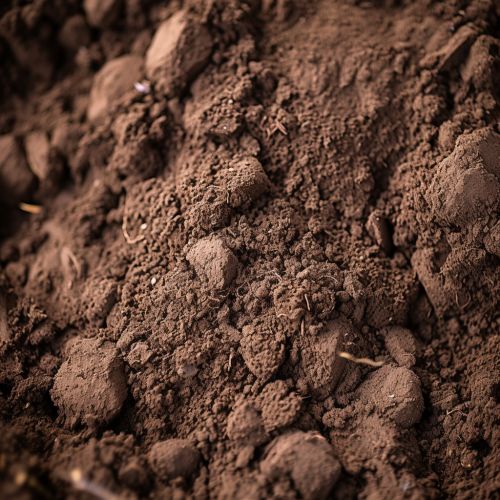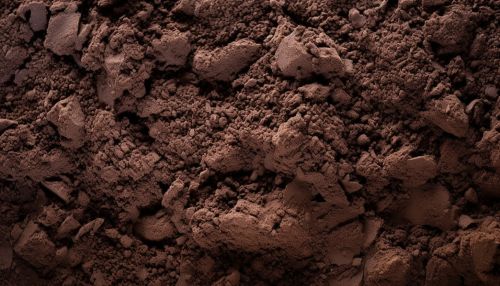Soil
Introduction
Soil, the uppermost layer of the Earth's crust, is a complex mixture of organic matter, minerals, gases, liquids, and countless organisms. It is the primary medium for plant growth and a vital component of terrestrial ecosystems, playing a crucial role in nutrient cycling, water purification, and carbon sequestration. Soil formation, or pedogenesis, is a dynamic process influenced by five key factors: parent material, climate, topography, organisms, and time.
Composition
Soil is composed of varying proportions of sand, silt, and clay, collectively known as soil separates. These particles are categorized by their size, with sand being the coarsest and clay the finest. The specific combination of these separates in a soil determines its texture, a key attribute that influences many soil properties, including water-holding capacity, nutrient availability, and susceptibility to erosion.
In addition to mineral particles, soil contains organic matter, derived from decomposed plant and animal material. This organic matter, or humus, enriches the soil with nutrients, enhances its ability to retain moisture, and promotes the formation of stable soil aggregates, improving soil structure.
Soil also contains a variety of gases, primarily nitrogen and oxygen, in the pore spaces between solid particles. These gases, which are exchanged with the atmosphere, are critical for the respiration of roots and soil organisms.
Lastly, soil is home to a vast array of organisms, from microscopic bacteria and fungi to larger creatures like earthworms and insects. These organisms contribute to nutrient cycling, organic matter decomposition, and soil structure formation, making them integral to soil health and fertility.
Soil Formation
Soil formation is a complex process that involves the interaction of five main factors: parent material, climate, topography, organisms, and time.
The parent material is the mineral matter from which the soil is formed. It can originate from bedrock, weathered rock, volcanic ash, or deposited material from wind, water, or glaciers. The type of parent material influences the soil's mineral composition, texture, and nutrient content.
Climate, encompassing temperature and precipitation, affects the rate of weathering and organic matter decomposition, thereby influencing soil formation.
Topography, or the landscape's shape and slope, can affect water drainage and erosion, which in turn influence soil development and distribution.
Organisms, including plants, animals, and microorganisms, contribute to soil formation through their effects on organic matter accumulation and decomposition, nutrient cycling, and physical soil properties.
Time is a critical factor in soil formation. Over thousands to millions of years, the interactions of the other four factors result in the development of distinct soil layers, or horizons, and the evolution of soils with unique properties and characteristics.
Soil Classification
Soil classification systems are used to group soils based on their properties and formation processes. The most widely used system globally is the World Reference Base for Soil Resources (WRB), developed by the International Union of Soil Sciences (IUSS) and the Food and Agriculture Organization (FAO) of the United Nations. The WRB classifies soils into 32 reference soil groups, such as Andosols, which are formed in volcanic ash, and Podzols, which are common in cool, humid regions.
Another widely used system is the United States Department of Agriculture (USDA) soil taxonomy, which classifies soils into 12 orders, including Mollisols, fertile soils found in grassland ecosystems, and Aridisols, which are characteristic of arid regions.
Soil Functions
Soil performs numerous vital functions in terrestrial ecosystems. It serves as a medium for plant growth, providing plants with physical support, water, and nutrients. It plays a key role in the cycling of nutrients, including carbon, nitrogen, phosphorus, and sulfur, which are essential for plant growth and ecosystem functioning.
Soil is also involved in water purification. As water percolates through the soil, pollutants and pathogens can be filtered out, improving water quality.
Additionally, soil acts as a significant carbon sink, storing more carbon than the atmosphere and all terrestrial vegetation combined. This makes soil management a critical consideration in efforts to mitigate climate change.
Soil Conservation
Soil conservation involves practices aimed at preventing soil erosion, maintaining soil health, and preserving its ability to perform its ecological functions. These practices include contour plowing, crop rotation, cover cropping, and the use of terraces and windbreaks.
Soil erosion, the removal of the topsoil layer by wind and water, is a major concern, particularly in agricultural landscapes. It can lead to reduced soil fertility, decreased agricultural productivity, and degradation of water quality. Therefore, implementing soil conservation practices is crucial for sustainable land management and food security.
See Also


